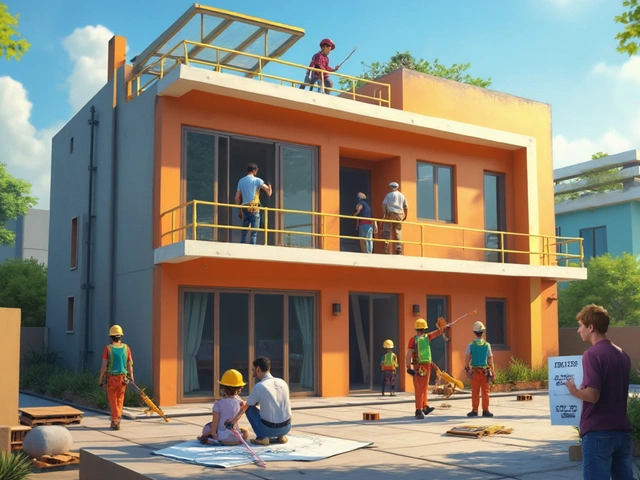Thinking about turning that dusty loft into something useful? You're not alone. As house prices keep climbing, more people are squeezing extra space out of what they already have. And loft conversions are one of the best ways to do it—whether you need a new bedroom, office, or just a quiet spot to escape.
But before sending builders up the stairs, you’re probably wondering, “How much is this going to set me back?” Here’s the straight answer: the average cost of a loft conversion in 2025 sits between £45,000 and £65,000 for a typical three-bed semi in the UK. Of course, that’s a ballpark. Some folks get it done for less, while others see the bill creep well above those numbers (especially in London or if you want all the bells and whistles).
Price tags vary depending on the type of conversion you’re after—just adding some roof windows and insulation costs way less than raising the roof or building an entire dormer extension. It’s not just about size either; things like roofing shape, plumbing, and even whether the stairs fit into your current layout all play a part.
If this sounds a little overwhelming, don’t sweat it. Once you know what affects the cost, and where you can trim the fat without losing quality, the whole thing feels way more doable. Let's break down the numbers, look at real-life breakdowns, and make sure you aren't caught off guard by surprise fees.
- Why Do a Loft Conversion Anyway?
- Breaking Down the Average Cost in 2025
- What Makes Prices Go Up or Down?
- Hidden Costs Most People Miss
- Tips to Save Money Without Cutting Corners
- Real Examples and What to Expect Next
Why Do a Loft Conversion Anyway?
If you’ve ever wished your house had just one more room, you’re not dreaming alone. More than 250,000 homes in the UK get a loft conversion each year. It’s become the go-to move for growing families, folks needing a home office, or those looking to bump up the value before selling.
Here’s the big draw: a loft conversion cost can feel steep, but adding usable space upstairs is almost always cheaper than moving house or building out at ground level. For most people, it’s about squeezing max value from what you’ve already got — especially when estate agents say you could add 15% to your home’s value with the right work.
Check out some of the common reasons people jump in:
- Extra Bedroom: Easily the most popular choice, especially with new arrivals or kids getting older.
- Home Office: More folks are working from home, and a quiet loft beats the kitchen table every time.
- Rental Income: Got space? A loft room with an en-suite brings in serious cash on platforms like Airbnb.
- Adding Value: According to Savills, even the basic conversion usually pays for itself if you sell within five years.
- No Need to Move: Avoid the stress and cost of stamp duty, removals, and all the rest.
If you’re into the numbers, here’s a clear look at how much of a value boost you might expect from different types of loft conversions, compared to the cost of actually moving house:
| Project | Average Cost (2025) | Typical Value Added |
|---|---|---|
| Basic loft conversion | £45,000 | ~10–12% |
| Dormer loft conversion | £55,000 | ~12–15% |
| Moving to a new 4-bedroom house | £120,000+ (after fees, stamp duty, moving costs) | New property, no extra value created |
If your roof space is just sitting there gathering dust, it might as well work for you. People are realising that with house prices not showing any real signs of dropping, the money you put into your loft usually makes sense. Even better—planning rules are a lot more relaxed now, so most regular loft conversions don’t need full planning permission, just a quick nod from Building Control.
Breaking Down the Average Cost in 2025
Let’s get straight to numbers so you know what to expect. For a basic loft conversion—think velux roof windows, insulation, and no major structural work—you’re typically looking at £20,000 to £30,000. This type is popular if you just want an extra bedroom or hobby space and don’t need an ensuite or big fancy finishes.
Most people go for what’s called a dormer loft conversion. This is where they build out from your roof to get full-height walls and lots more usable room. Prices for these start around £45,000 but often land closer to £55,000 or £60,000, especially if you add a bathroom or high-end finishes. In London or the South East, bump those numbers up by about 20-30% thanks to higher labour, material costs, and sometimes stricter rules.
If your house needs a hip-to-gable or mansard conversion (usually for end-of-terrace or detached homes), you could be staring at £60,000 to £80,000. These are the serious makeovers—perfect if you want a master suite or two extra rooms.
- Loft conversion cost for an average UK home (velux): £20,000–£30,000
- Dormer loft conversion: £45,000–£65,000
- Hip-to-gable or mansard conversion: £60,000–£80,000+
Don’t forget you’ll pay extra if you want top-of-the-line fixtures, bespoke built-ins, or underfloor heating. Oh, and those slick spiral staircases? Cool, but they’re not cheap. Most builders will give you a quote that covers structural work, insulation, windows, and basic electrics and plumbing—but rarely things like new carpets, wardrobes, or fancy tiles. Those all sneak onto your final bill, so keep them in mind.
The bottom line: always ask for a detailed quote that spells out what’s included. That way there’s no awkward surprises when you see the bill.
What Makes Prices Go Up or Down?
There’s no magic number for the real cost because so many things can mess with your budget. Some of them are obvious, while others catch people totally off guard. Let’s break them down.
- Type of Loft Conversion: This has the biggest impact. The cheapest way in is a simple rooflight (just windows and a bit of boarding), usually under £30,000. Dormer extensions (sticks out from the roof, more space and light) are the most popular, but cost more—think £45k-£70k. Mansard conversions (major roof rebuilds) are top of the range for space but easily hit £75k+.
- Roof Shape and House Layout: If you have a steep roof with plenty of height, you’ll need fewer structural changes. Low or flat roofs can mean raising the whole thing, which means more money.
- Where You Live: Costs are always higher in London and the South East. Expect labour and materials to bump up your total by 20–30% compared to the Midlands or North.
- Size Matters: Bigger lofts cost more for obvious reasons—more materials, more work, more everything. The more en-suites, storage, and extras you want, the higher the price.
- Access and Stairs: If your house makes it easy for a staircase to slot in, great. But if space is tight, you could need a custom staircase or even lose a chunk of another room, which adds to the bill.
- Quality of Finish: Want standard stuff and simple décor? You’ll save. Choose fancy fitted wardrobes, high-end tiles, or Bluetooth showers, and you’ll see your spend jump.
One more thing: don’t ignore the paperwork. Planning permission, architect fees, and building regulations all cost money. Skipping these bits isn’t an option—they’re not just red tape, they keep your build legal and safe.
The bottom line? The loft conversion cost is always a mix of what you want, what your home allows, and where you live. Knowing this upfront means fewer nasty surprises and way better choices.

Hidden Costs Most People Miss
It’s easy to get caught off guard once work gets going. Even after you’ve got a quote in hand, loft conversion cost can sneak up higher with a bunch of extras folks don’t always plan for. Some are tiny but add up, others can ding your wallet big time.
One of the biggest things people skip over is building regs and planning fees. Even if you don’t need planning permission, you’ll almost always need building regulation sign-off, which can reach £1,000–£2,000. If you live in a listed building or a conservation area, your local council might tack on more.
Think your old electrics and plumbing will just slot in? Not always. Rewiring and putting in extra sockets, moving radiators, or adding a new bathroom up there can all bump up your bill. Plumbing in a new ensuite alone can come in at £3,000–£5,000. Plus, if your water pressure isn’t good enough for an upstairs bathroom, you might have to upgrade your boiler or add a pump.
Stairs are another classic curveball. Even though you know you need them, winding staircases or moving walls to make space can mean more structural work, which pushes both time and costs up. If you’re short on ceiling height, lowering the floor below is no joke, and that’ll take a decent chunk out of your budget.
Here’s a quick rundown of common hidden charges:
- Structural engineer’s report – £400–£800
- Party wall agreement (if you have sharing neighbours) – £1,000–£2,000
- Upgrading insulation to meet current regs – £1,500–£2,500
- Extra scaffolding charges (especially if access is tricky) – £1,000+
- Decorating and finishing – £2,000–£4,000
Costs can also pile up if asbestos is found during the work—removal and making things safe might cost £1,000–£3,000, depending on how much is there. And don’t forget extra costs for skips, waste removal, and parking permits for builders, which are super common in city areas.
| Item | 2025 Estimated Cost |
|---|---|
| Building Regs Approval | £1,000–£2,000 |
| Party Wall Surveyor | £1,000–£2,000 |
| Structural Engineer | £400–£800 |
| New Plumbing (Ensuite) | £3,000–£5,000 |
| Extra Insulation | £1,500–£2,500 |
| Asbestos Removal | £1,000–£3,000 |
| Decorating/Finishing | £2,000–£4,000 |
| Extra Scaffolding | £1,000+ |
Maybe the most frustrating thing: these extras usually aren’t in the builder’s main quote. So, when you’re budgeting, it seriously pays to leave a chunk extra (10%–15% at least) as a buffer. Otherwise, you’re stuck scrambling right when you want to be settling in.
Tips to Save Money Without Cutting Corners
If you're staring at quotes for a loft conversion and feeling your wallet break out in a cold sweat, you're not alone. The good news: there are real ways to spend less without ending up with shoddy results.
First, always get at least three detailed quotes from builders—don’t just grab the cheapest. Cheaper isn’t always better, and dodgy work will cost more to fix later. Compare exactly what’s included: some quotes hide stuff like scaffolding, finishes, or even VAT.
Consider what’s called a “shell-only” loft conversion. In this setup, a builder handles the structure, stairs, and insulation—then you finish plastering and decorating yourself, or with local trades. This can save you up to 20% versus a fully finished job.
Stick to the original plans once work has begun. Chopping and changing after they’ve started almost always racks up extras—sometimes by a few thousand pounds, just for minor tweaks.
Source your own fixtures and fittings when possible. Builders’ “supply and fit” prices often come with a markup. Shopping for your own lights, flooring, and bathroom fittings can cut costs, but check with your contractor that what you buy actually fits the design.
Don't forget loft conversions can be done all year, but some trades charge less outside peak summer months. If you’re flexible on timing, you might negotiate a better deal in the autumn or winter.
Here’s a quick table of cost-saving moves and what they could knock off your bill:
| Money-Saving Move | Average Savings (£) |
|---|---|
| Shell-only conversion | 8,000 - 12,000 |
| Sourcing own fittings | 1,500 - 3,000 |
| Out-of-season build | 500 - 2,000 |
| Minimal changes to plans | 2,000 - 4,000 |
One last tip: If your home’s loft conversion cost goes over budget, find out why. Keep an eye on invoices and ask for receipts. Open communication with your builder avoids drama later and helps you catch any sneaky extras before they snowball.
Real Examples and What to Expect Next
Nothing beats real numbers when it comes to figuring out what a loft conversion cost actually looks like in practice. People talk all day about averages, but let’s see some concrete cases.
Take a typical three-bed semi in Greater Manchester. One family in 2024 added a master bedroom and bathroom with a rear dormer. They spent £52,000 all-in. That covered insulation, dormer build, electrics, plumbing, en-suite fittings, and a basic finish. Skip the en-suite, and their neighbours down the street paid just under £44,000 for a similar setup—showing how extra features stack up quickly.
In London, prices jump. A couple in Croydon went for a L-shaped dormer to create both a spare room and a small office. Their bill hit £67,000. They said the extra £2,500 for custom-made oak stairs felt brutal, but having natural light over both rooms made a big difference, so they felt it was worth it.
Here’s a snapshot of three real projects from the past 12 months:
| Location | Type | Rooms Added | Total Cost (£) |
|---|---|---|---|
| Leeds | Rooflight | 1 Bedroom | 38,500 |
| Surrey | Dormer | Bedroom + En-suite | 59,200 |
| Bristol | Mansard | 2 Bedrooms | 76,000 |
As you can see, loft type and what you add make a massive difference. Even a simple rooflight conversion can be under £40,000, but that’s just a bedroom. Want two rooms and a bathroom? Add at least £20k more, maybe more if you’re near London or need extra steelwork.
If you’re weighing up your own plans, here’s what usually happens next:
- First, get a survey. Local builders or loft specialists can visit for free or a small fee, measuring up and giving design options.
- Second, set a realistic budget. Always add 10-15% wiggle room for stuff you can’t predict—like extra steel beams or planning tweaks.
- Third, gather quotes. Don’t go with the first or even the cheapest. Compare what’s actually included—some will price low but add things like scaffolding or skip hire later.
- Fourth, check references and don’t skip a proper contract. If it’s not written down, don’t assume it's included.
The honest truth? If you stay organised and keep your expectations in check, you’ll get the extra space you need without nasty shocks—just be ready for some banging and dust along the way. And if you can, talk to neighbours who did their own conversion. First-hand reviews beat online estimates every time.




Write a comment